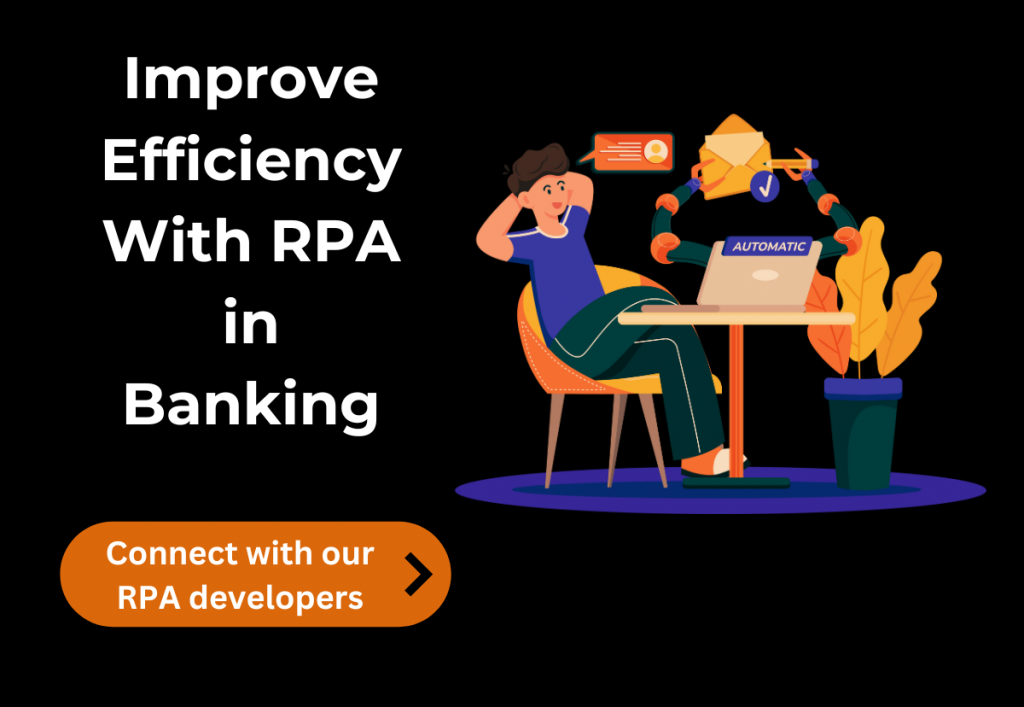Banking includes several operational tasks, so better operation management and productivity are necessary. This is where we bring in RPA in the banking industry. This will help the banks not only optimize costs but also enhance the overall efficiency of the work. It will help them improve their work efficiency and provide a great customer experience.
If you are wondering how RPA will assist banking operations, you are certainly on the right page. We are here to help you understand the subject so that you can move ahead with complete clarity. Below, we will discuss all the aspects related to RPA in the banking industry and make it easy for you to proceed.
Table of Contents
How RPA is Driving Digital Transformation in Banking
Digital transformation has wholly hooked the industry on every level. Whatever the industry, digital transformation is the need of the hour, and the most prominent feature that helps in the process is Robotic process automation. If you are thinking about how banking can be affected through digital transformation, we will help you understand all its related aspects; check it out.
- Firstly, it will help the banks streamline operations in every department.
- Secondly, it will be key in improving the work’s accuracy.
- Also, it will help reduce the costs incurred for the operations.
These aspects show how automating will enhance banking operations and make it easier for them to serve their customers. Eventually, it allows us to save costs and boost customer satisfaction, leading to more recommendations. In this way, it assists banks in doing more business and eventually getting ahead in the competition.
Hence, RPA in the banking industry is undoubtedly the way to go, and if you are wondering how it is making an impact, we will give you the numbers.
Robotic Process Automation (RPA) in Banking: Key Statistics
Now, we will look at the numbers highlighting the importance of the RPA in banking. Below are the essential stats that define the overall integration of RPA in banking and how the impact will be.
- 10 to 25% of banking processes can be automated, leading to exquisite cost savings.
- A bank with 125,000 customers can save up to $100 million during onboarding and another $100 million every three years by automating ongoing monitoring processes.
- The market for RPA services and software will continue to grow, and more than 80% of finance leaders are moving towards this approach in their operations.
These numbers show how RPA applications in banking are undoubtedly the way to go and will improve efficiency. Now that you are thinking about how it will improve in every department, the use cases below will certainly assist. Read on.
Use Cases of RPA in Banking
Now, we will discuss the different use cases of RPA in banking, which will give you clarity about how it will improve the other operational departments. Let’s dive in.
RPA for Customer Onboarding
Banks’ customer onboarding process is critical, and RPA can significantly streamline this operation. RPA use cases in banking include automating the collection and verification of customer data, document processing, identity verification, and account setup. By automating these tasks, banks can reduce onboarding time, minimize errors, and improve the overall customer experience.
| Task | Traditional Time | Time with RPA |
| Onboarding Request | 3-6 weeks | Reduced |
| Document Gathering | 1-4 weeks | Reduced |
| Background Verification | 2-4 weeks | Reduced |
| Credit Terms Setup | 1-3 weeks | Reduced |
| Agreement Management | 1-3 weeks | Automated |
| Account Setup | 1-2 weeks | Reduced |
| Tracking & Archiving | Ongoing | Automated |
| Analytics & Cross-selling | Ongoing | Automated |
Automating KYC and AML Processes with RPA
Know Your Customer (KYC) and Anti-Money Laundering (AML) processes are essential for regulatory compliance. RPA in the banking industry can automate compliance checks, monitor transactions, and identify potential risks, ensuring adherence to regulatory standards. This includes automating AML checks and KYC processes minimizing the risk of penalties and legal issues.
Loan Processing Made Efficient with RPA
RPA streamlines the loan processing lifecycle, from application submission to approval. Banking RPA applications can automatically gather and validate information, perform credit checks, and generate loan agreements. By automating these steps, banks can significantly reduce processing times, enhance accuracy, and improve overall customer satisfaction. One bank reduced application processing times by 80% and human error by 100% by implementing an RPA solution.
Fraud Detection and Prevention
RPA in banking includes automating fraud detection and prevention. RPA can monitor transactions, flag suspicious activities, and generate alerts for further investigation. By analyzing patterns and detecting anomalies, RPA helps banks prevent fraud, protect their reputation, and deliver excellent customer service.
Streamlining Account Closure with RPA
Account closure is another area where RPA can improve efficiency. RPA can automate the process of closing accounts, ensuring that all necessary steps are completed accurately and promptly. This includes verifying customer information, processing final payments, and updating account records.
RPA for Compliance and Regulatory Reporting
Compiling compliance and regulatory reports is time-consuming and requires the utmost accuracy. Robotic process automation in banking assists in automating compliance-related processes and generating reports for internal and external auditors or compliance officers. This reduces manual effort, improves accuracy, and helps banks meet regulatory deadlines.
Improving Customer Service with RPA-Powered Chatbots
RPA-powered chatbots can enhance customer service by quickly and accurately responding to customer inquiries. These chatbots can handle various tasks, such as answering questions about account balances, processing transactions, and providing support. By automating these interactions, banks can improve customer satisfaction and reduce the workload on human agents.
Automating Credit Card and Mortgage Processing
RPA can automate various credit card and mortgage processing tasks, such as verifying customer information, processing applications, and generating reports. By automating these processes, banks can reduce processing times, minimize errors, and improve overall efficiency.
Risk Assessment and Mitigation Using RPA
RPA in banking can be used for risk assessment and mitigation by automating transaction monitoring and identifying potential risks. It can analyze patterns, detect anomalies, and generate alerts for further investigation, helping banks manage risk and prevent losses proactively.
Enhancing Internal Audit Processes with RPA
RPA can enhance internal audit processes by automating data collection and analysis. This includes reviewing financial records, identifying discrepancies, and generating reports. By automating these tasks, banks can improve the efficiency and effectiveness of their internal audits.
RPA for Payment Processing and Reconciliation
RPA can automate payment processing and reconciliation, ensuring that transactions are processed accurately and promptly. This includes automating the verification of payment information, processing payments, and reconciling accounts. By automating these processes, banks can reduce errors, improve efficiency, and enhance customer satisfaction.
RPA for Data Management and Analytics
RPA use cases in banking also include automating data management and analytics tasks. RPA can automate data collection, cleaning, and analysis, providing banks valuable insights into their operations and customers. This information can improve decision-making, optimize processes, and enhance customer service.
Predictive Customer Retention Strategies
By analyzing customer data, RPA can help banks identify customers at risk of leaving. This information can be used to develop targeted retention strategies, such as offering personalized incentives or proactive support. By retaining valuable customers, banks can increase revenue and improve customer loyalty.
Multi-Channel Marketing Automation
RPA can automate multi-channel marketing campaigns, ensuring customers receive timely and relevant messages across various channels. This includes automating the creation and distribution of email campaigns, social media posts, and other marketing materials. By automating these tasks, banks can improve the effectiveness of their marketing efforts and drive customer engagement.
Fully Automated Treasury Management
RPA can automate treasury management tasks, such as cash forecasting, investment, and risk management. This includes automating the collection and analysis of financial data, generating reports, and executing transactions. By automating these processes, banks can improve the efficiency and effectiveness of their treasury operations.
Key Benefits of RPA in Banking
When you are clear about the use cases of the RPA in banking, you need to look at the benefits of the respective process. Check it out.
- Firstly, RPA will boost operational efficiency by automating repetitive tasks. This reduces manual effort and certainly accelerates operation times. This allows employees to focus on more core business activities that can boost productivity.
- Automating human work with RPA will play a key role in cost reductions. It will minimize the need for manual disruptions, and banks can significantly reduce operational expenses.
- Thirdly, RPA bots will help banks accurately and consistently execute the tasks. All this will be done by eliminating human errors.
- Fourthly, RPA will automate the compliance checks and generate comprehensive reports. This will adhere to evolving financial regulations and assist in generating full audit trails.
- Lastly, RPA streamlines banking processes and eventually assists in providing faster and more accurate service to customers. This will play a key role in improving customer satisfaction and boosting recommendations.
Challenges of Implementing RPA in Banking
Implementing RPA in the banking industry will undoubtedly bring benefits, but there are also some challenges to look forward to. Check out the same.
- Ensuring the security of sensitive customer data is crucial.
- Integrating RPA with legacy systems can be complex and challenging.
- Implementing and managing RPA requires specialized skills and expertise.
- Scaling RPA solutions to meet changing business needs can be demanding.
- Overcoming resistance to change and ensuring employee buy-in is essential.
Steps to Successfully Implement RPA in Banking
Below are the essential steps followed in the world of RPA development for banking to assist you in achieving the desired objectives. Check it out.
To successfully implement RPA in banking, banks should follow a structured approach.
Step 1:
Conduct a comprehensive analysis to pinpoint repetitive, rule-based tasks ripe for automation. Focus on processes involving high volumes of data manipulation across multiple systems, such as account onboarding, loan processing, and regulatory compliance. Prioritize those offering the highest potential return on investment (ROI).
Step 2:
Scrutinize the chosen tasks to determine their viability for RPA implementation. This involves process mapping to uncover potential challenges and areas for enhancement. Define the scope, timeline, and milestones for implementation, assigning responsibilities to the appropriate personnel.
Step 3:
Research and select an RPA platform that integrates seamlessly with your existing banking systems. Consider factors like scalability, security, and ease of use. Pilot programs with selected tools can assess their effectiveness in specific environments. Ensure the provider aligns with the institution’s requirements for a reliable partnership.
Step 4:
Create a detailed plan outlining the steps for RPA implementation. This plan should include timelines, resource allocation, and key performance indicators (KPIs) to measure success. A well-defined plan minimizes risks and ensures a smooth implementation process.
Step 5:
Execute the RPA solution according to the developed implementation plan. This involves configuring the RPA bots to perform the identified tasks. Integration with existing IT infrastructure is critical, requiring careful planning and coordination.
Step 6:
Thoroughly test the RPA solution before deploying it to a production environment. This includes ensuring the accuracy and reliability of the automated processes. After testing, the RPA solution will be deployed using a phased approach to minimize disruption.
Step 7:
Continuously monitor the RPA solution to ensure it functions correctly. Regularly maintain and update the solution to adapt to changing business needs and regulatory requirements. Improved reporting on robot performance is desired for better monitoring.
These are the essential steps followed by business experts to implement RPA in banking. You must connect with the experts at A3Logics to reap the benefits mentioned above.
Future Trends of RPA in Banking
The future of RPA in banking is bright, with several emerging trends expected to shape the industry:
- AI-Powered RPA: Integrating artificial intelligence (AI) with RPA will enable more advanced automation capabilities.
- Cloud-Based RPA: Cloud-based RPA solutions will offer greater scalability and flexibility.
- Low-Code RPA: Low-code RPA platforms will make automating tasks easier for non-technical users.
- Intelligent Document Processing: RPA will be combined with intelligent document processing (IDP) to automate the extraction and processing of data from unstructured documents.
- Hyperautomation: RPA will be integrated with other automation technologies, such as business process management (BPM) and AI, to create end-to-end automation solutions.
How A3Logics Can Assist in Banking Transformation Using Robotic Process Automation (RPA)?
A3Logics is a leading artificial intelligence development company with extensive experience providing RPA development services to the banking industry. We help banks streamline their operations, reduce costs, and improve customer experiences by leveraging RPA’s power in the banking industry. Our team of experts works closely with banks to identify RPA use cases, develop customized solutions, and implement them seamlessly. We offer a full suite of RPA development services, including consulting, implementation, and support.
Final Words
RPA in banking is a transformative technology that offers numerous benefits to banks. By automating repetitive tasks, reducing errors, and improving efficiency, RPA helps banks optimize costs, enhance customer experiences, and maintain a competitive edge. Implementing RPA presents challenges, but following a structured approach and partnering with an experienced AI development company like A3Logics can ensure success. As RPA technology continues to evolve, banks that embrace it will be well-positioned to thrive in the digital age.
FAQs
What is Robotic Process Automation (RPA) in banking?
Robotic Process Automation (RPA) in banking is a technology that automates repetitive, rule-based tasks using software bots. These bots can mimic human actions, such as data entry, document processing, and transaction processing.
How does RPA improve customer experience in banking?
RPA improves customer experience by streamlining processes, reducing processing times, and minimizing errors. This leads to faster and more accurate service, enhancing customer satisfaction.
How long does it take to implement RPA in banking?
RPA implementations typically take months or weeks, far shorter than traditional IT projects. The exact timeline depends on the complexity of the project and the bank’s specific needs.
Can RPA work with legacy banking systems?
Yes, RPA can work with legacy banking systems. RPA bots can interact with legacy systems through their existing interfaces without requiring changes to the underlying systems.
How do banks measure ROI for RPA projects?
Banks measure ROI for RPA projects by tracking cost savings, error reduction, and efficiency improvements. These metrics are compared to the initial investment in RPA to calculate the ROI.
How scalable are RPA solutions in banking?
RPA solutions in banking are highly scalable. Banks can quickly scale their RPA deployments up or down to meet changing business needs.
How does A3Logics support RPA implementation in banking?
A3Logics supports RPA implementation in banking by providing a full suite of RPA development services, including consulting, implementation, and support. Our team of experts works closely with banks to identify RPA use cases in banking, develop customized solutions, and implement them seamlessly.






